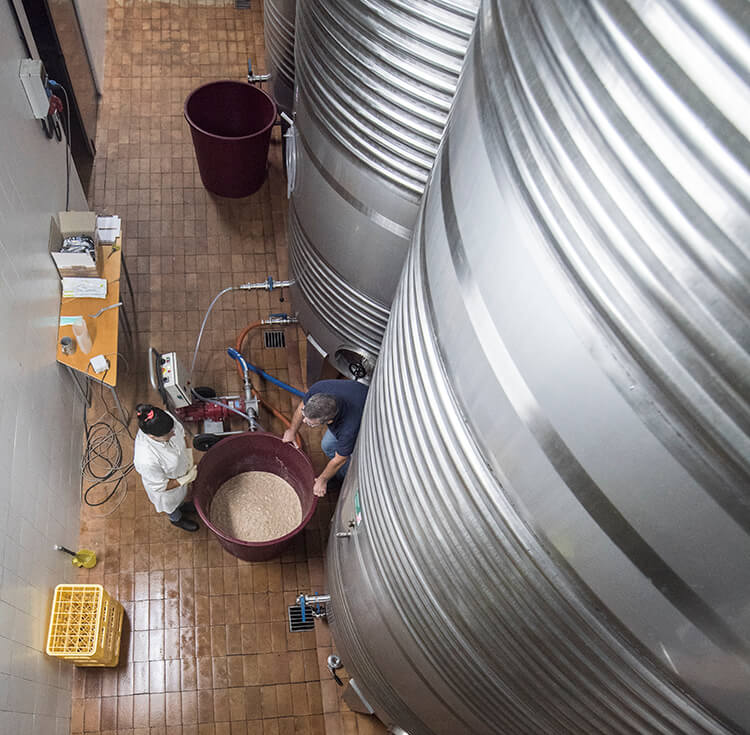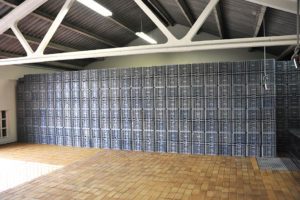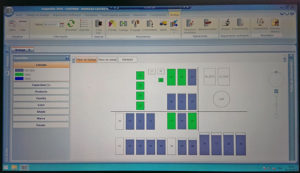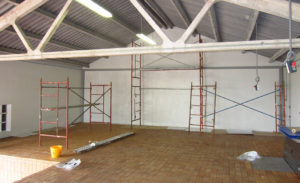It’s all happening… in the cellar!
September 24th, 2019 | Bodega



Our cellar team are finally coming to the end of the post-harvest deep clean (only started once all fermentations were complete and tanks could be closed and secured). I walked into one of tank storage rooms this morning, and for a split second it almost looked like it had been snowing. The tanks and the floor were veiled in white – but of course, it wasn’t snow!
We have a special cleaning product for stainless steel which is applied by machine as a foam. Just to clarify for a moment, all the cleaning products that we use are both approved for use in food (wine) production areas, and are environmentally friendly.
Not only do all the wine making products that we use have to be approved and recorded, but this also applies to cleaning materials. These days every process and product has to be recorded – it is part of what is known as traceability. Heaven forbid, if something should go wrong, and there is a problem with one of our wines, then not only can the entire batch be withdrawn from sale, but we can then look back through our records, tracing back, if necessary, to the origin of every grape that went into a particular bottle. That’s what traceability is all about – consumer protection.

One of the biggest post-harvest jobs that we have to do, apart from the wine making, is cleaning the cases that were used for collecting grapes – we have about 2,000 of these.
In previous years they were washed case-by-case using a pressure washer, simply because there was always a build up of grape juice almost ‘baked’ onto the plastic. This year it is a little different….
With our new case washing machine (inaugurated at the beginning of the harvest), every case was washed thoroughly each time it was used. A conveyor-like system pulls each case into the machine where it is ‘attacked’ from all sides by a set of high pressure water jets – this removes all the lose dirt. It then undergoes a second wash in clean water (re-cycled through filters) before it is left to dry. The result is that, over the period of the harvest, there is no dried juice build-up (our old wash-by-hose method was not quite so effective), and the cases are always completely clean and dry.
At the end of the harvest we now simply give all the cases one more final wash before they were stacked away for next year. Any that that fail inspection are separated and undergo a quick pressure wash to remove all residuals. This year, using the machine for this final wash took just over one working day, whereas our old method employed three people for a period of up to two weeks! Now that’s what I call a labour (and cost) saving investment!

Just when you think that all the hard work, collecting grapes is done, then it all starts again inside the bodega. We have two huge programmes running simultaneously with one another…. The first is a deep clean, and when I say deep clean, it really has to be deep! Grape juice must be one of the stickiest substances on the planet (perhaps it could give Gorilla Glue a run for it’s money!) To be honest it’s not really ‘super’ sticky but it’s special property is that it simply transfers everywhere – there are few places that escape, so much so that a full change of clothes and shoes is really essential at the end of each working day. So now the task in hand is that we have to unstick everything, by far the most difficult chore being the presses – the epicentre of juice production.
The second, and most important project is getting the fermentation under way. I did post a quick photo a day or two ago, taken as we started to re-hydrate the yeast, but once this is done then it has to be carefully and slowly added to each tank, one-by-one. The process of seeding a single large tank (see photo) can take up to 4 or 5 hours – the smaller tanks are a bit quicker, taking about 3 hours. Of course this time includes the pumping-over after the yeast is added. Pumping over is simply a mixing process, when we connect the top of the tank to the bottom using hoses, and then circulate the juice and yeast mixture in a cyclical motion for a couple of hours.
The timing of fermentation is determined by the juice, when, after cold settling, the temperature recovers to a level warm enough to support the yeast. If the juice is too cold, then the yeast will simply die of shock – the result? No fermentation!
This year the temperature dictated that we were here for the entire weekend, meaning that for the last two or three weeks, none of us have had a break! Who was it said that running a wine cellar is a romantic profession?!
 The one thing that our recent photos have in common, is that they are all taken under clear blue skies. For the first couple of days of November we experienced two or three of days of rainfall, and of course, we simply assumed that our normal Galician winter had finally taken hold….. not at all. Within a week the skies had cleared completely, and the fine, sunny weather continued. To be honest, we really need some sustained rainfall even if it will make it extremely uncomfortable for our guys who will start pruning in a few weeks time.
The one thing that our recent photos have in common, is that they are all taken under clear blue skies. For the first couple of days of November we experienced two or three of days of rainfall, and of course, we simply assumed that our normal Galician winter had finally taken hold….. not at all. Within a week the skies had cleared completely, and the fine, sunny weather continued. To be honest, we really need some sustained rainfall even if it will make it extremely uncomfortable for our guys who will start pruning in a few weeks time.
The combination of this dry weather and the comparatively early harvest this year have enabled us to squeeze in a few additional jobs before the start of pruning. An unsightly piece of ground (actually more of a ‘dumping ground’) adjacent to the grape reception has been cleared, and the back of the bodega completely repainted…. Considering all the building and maintenance that we have carried out this year then perhaps we should start a construction business as a sideline! Having said that it’s amazing what a bit of cleaning and a lick of paint can make, even if people rarely visit the rear of our bodega.
 We have quite a few tough, and sometimes boring tasks to complete during our working year – for example, pruning is one that I often quote. After the harvest, however, we have to complete many different cleaning chores, one of which is cleaning all the plastic cases used for gathering the grapes. More than 2,000.
We have quite a few tough, and sometimes boring tasks to complete during our working year – for example, pruning is one that I often quote. After the harvest, however, we have to complete many different cleaning chores, one of which is cleaning all the plastic cases used for gathering the grapes. More than 2,000.
Until we can work out a better system, this is all done by hand, or rather with high pressure jet washers. Whilst we do wash the cases between uses, as they are constantly re-cycled during the picking, they still tend to build up a layer of dust, and always tend to look a bit grubby at the end of the campaign. The washing process occupies two or three people for a period of about two weeks, before they are stacked in the grape reception ready for next year.
These cases, like the presses, the pressing room and the grape reception itself are simply the materials and parts of the bodega that sit completely dormant for about 11½ months of the year!
 Just before the harvest (apart from all our preparation work), we were occupied by a series of computer training sessions. Well, not so much computer training, but rather software training. During 2017 we have been progressively rolling out our new, updated software package. We started with accounts, eventually moving on to stock, bottling, labelling and then finally, we turned to the harvest. This has been a huge undertaking, and despite the training (carried out mostly at break-neck speed), we are now trying to put into practice all the procedures that we were shown in theory – and it is by no means an easy task!
Just before the harvest (apart from all our preparation work), we were occupied by a series of computer training sessions. Well, not so much computer training, but rather software training. During 2017 we have been progressively rolling out our new, updated software package. We started with accounts, eventually moving on to stock, bottling, labelling and then finally, we turned to the harvest. This has been a huge undertaking, and despite the training (carried out mostly at break-neck speed), we are now trying to put into practice all the procedures that we were shown in theory – and it is by no means an easy task!
Indeed, we made a decision at the very beginning of the harvest that we would only enter the bare minimum of information into the system, and the vast majority we would input later when the pressure was off (keeping copious records on paper as in previous vintages). The last couple of weeks, we have spent hour after hour staring at our screens, sometimes just trying to figure out how to make it all work – connecting the theory with the reality is not quite as simple as you might think.
Although today’s photo is not very high quality you might still be able to make out that nearly every tank in our cellar is full. A few tanks are deliberately left empty merely give us some space to work – for example, when racking, we need to have at least one empty tank to re-locate the wine.
 I just finished writing an e-mail to someone a moment ago, apologising that our bodega was in a bit of a ‘limbo’ state during their very recent visit. Meaning that whilst our obvious priority is the wine making, we are also undertaking cleaning, some re-painting and preparing orders. This period of activity is almost more exhausting than the harvest itself. Clocks and calendars are completely meaningless as all of our days fuse into one long extended week – weekends simply don’t apply. Our work timetable is dictated entirely by all the essential cellar work as the transition from must into wine bluntly refuse to take a day off!
I just finished writing an e-mail to someone a moment ago, apologising that our bodega was in a bit of a ‘limbo’ state during their very recent visit. Meaning that whilst our obvious priority is the wine making, we are also undertaking cleaning, some re-painting and preparing orders. This period of activity is almost more exhausting than the harvest itself. Clocks and calendars are completely meaningless as all of our days fuse into one long extended week – weekends simply don’t apply. Our work timetable is dictated entirely by all the essential cellar work as the transition from must into wine bluntly refuse to take a day off!
Unfortunately (from a rest day point of view), the weekend just gone was probably the busiest of the entire wine making process. With the fermentations well under way, as I have previously mentioned, there are quite a number of tank additions that have to be made at this time – bentonite perhaps being the most significant of these. Bentonite is our choice of fining agent, for clarifying our wine, and was first discovered in Fort Benton, Wyoming (so no prizes for where the name originates), and is a type of clay made from volcanic ash. Not only does the bentonite drag all the unwanted solids and dead yeasts to the bottom of the tank, but also helps to keep the wine stable during fermentation. As it is a natural product, it also means that all of our wines are suitable for vegetarians.
Our grape reception area which was extended just before harvest, is now getting just a little more pampering as we give it a new lick of paint, just before we re-fill it completely with 2,000 empty harvest baskets ready for next year. For a space that is only used for 7-10 days a year, it’s certainly had more than it’s fair share of attention recently!
Something very interesting happened this morning when I got out of bed – I didn’t rush to the window to check on the weather. I also stopped trawling through the weather websites, at least until next year. So when I eventually did leave home and discovered that it actually was raining, I really didn’t care!
So our attention now turns to the contents of our tanks – the grape must. The first thing that I have to say is that we are thrilled with the fruit that we have collected, and so taking into account that quality ALWAYS originates in the vineyard, we should have have the raw material to make some very good wine in 2017 (to sell in 2018).
It’s true to say that no matter how much experience we have working our harvests, we will always be looking for new ideas and ways to improve our working practices in the future. We keep notes of these ideas, discuss them, and then perhaps incorporate one or two in the next vintage. There are also clearly one or two things that are fundamental to a successful campaign – forward planning is vitally important to a smooth and less stressful harvest, as is having a well organised, well-drilled team around us – thankfully we do.